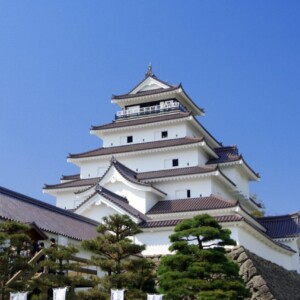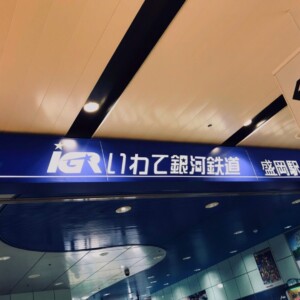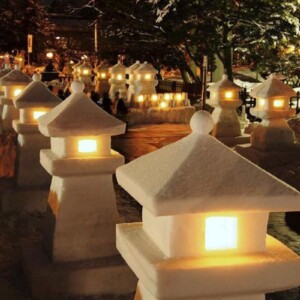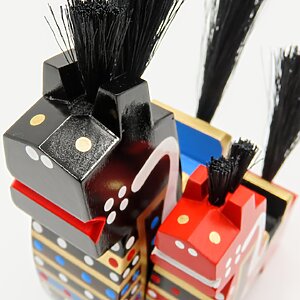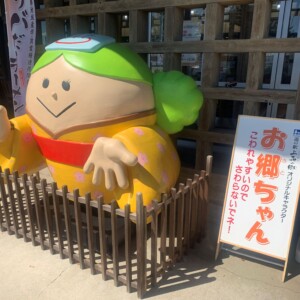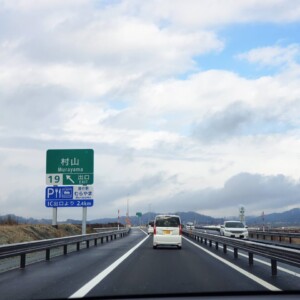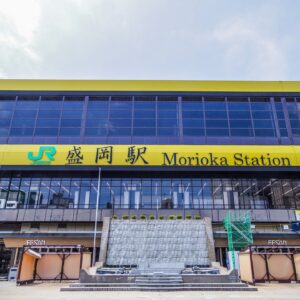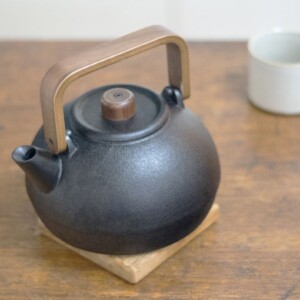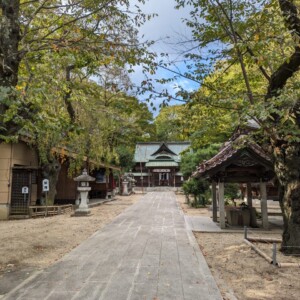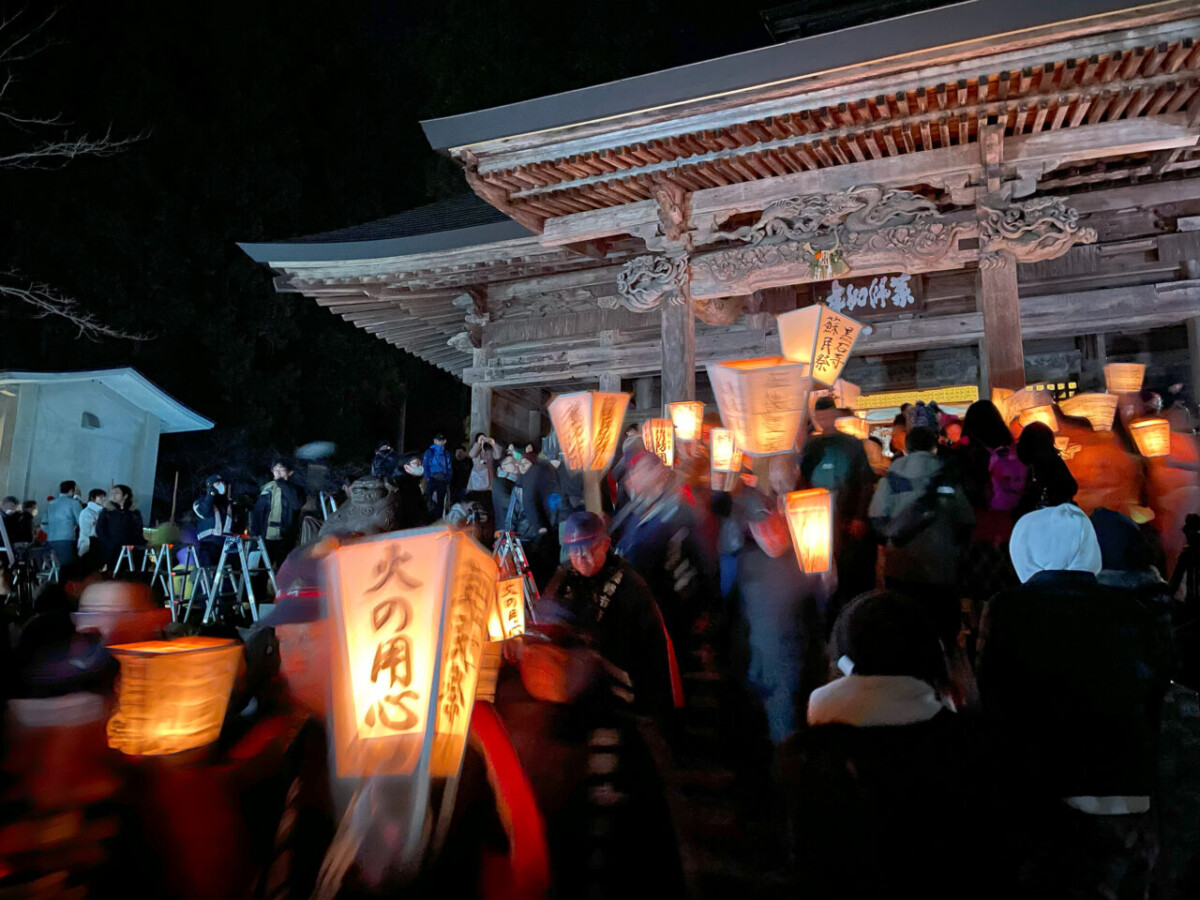
Kuroishiji Somin Festival, which has brought the curtain down over 1,000 years of history | 2024 local report [Iwate Prefecture]
table of contents
- 1 What is Sominsai?
- 2 2024 Kuroishiji Somin Festival
- 2.1 Arrive early and take a walk around Kuroishi Temple during the day
- 2.2 At 6pm, the Somin Festival finally begins!
- 2.3 After 7:00 p.m., the bell rings and the Betto Nobori climb begins.
- 2.4 Unable to bear the fatigue, I decided to eat and take a break.
- 2.5 I tried to go back to the main hall after a short break, but...
- 3 summary
This year marks the end of the Kuroishiji Temple Somin Festival, which has a history of more than 1,000 years. It has been a hot topic in various places since early on, but I can't let it pass without having seen it even once! So I went there to see it for myself!
What is Sominsai?
The Sominsai Festival, which is held mainly in the southern part of Iwate Prefecture to pray for a good harvest and good health, was established in 1995 as an intangible folk cultural property that requires measures such as record-keeping. It is one of Iwate Prefecture's representative traditional cultures, selected by the Agency for Cultural Affairs.
Among them, the Kuroishiji Somin Festival, which is held all night from the 7th of the Lunar New Year at Myokenzan Kuroishi Temple in Mizusawa, Oshu City, is a festival with a history of over 1,000 years and is considered the most famous Somin Festival. It is no exaggeration to say so.
Details are summarized in the article below.
2024 Kuroishiji Somin Festival
The last Sominsai was held on Saturday, February 17, 2020 (8th day of the Lunar New Year), and the time was from 18:00 to 23:00, which is the original form of holding all night. was held with significant changes. This may be because a large number of visitors were expected as it was the last event. If you go during the original hours (from 10pm until dawn), viewers will need to be very prepared.
Arrive early and take a walk around Kuroishi Temple during the day
We were told that the temporary parking lot only had a capacity of about 200 cars, so we decided to arrive at the site around 1:00 pm and wait until the festival time.

By this time, many members of the media were already busily preparing at various locations within the temple grounds. You will once again realize how much attention it attracts as the "last night" of a festival with a history of over 1000 years
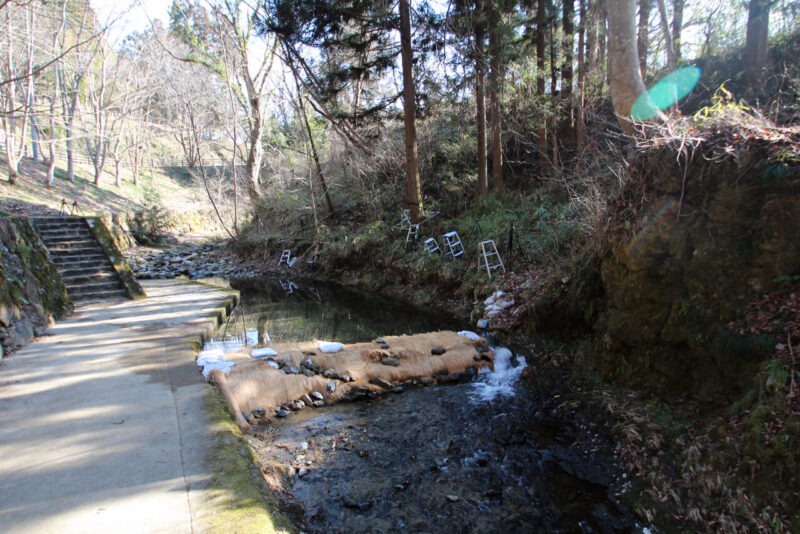
Yamauchi River, where the procession of ``Naked Shrine'' is held at the beginning of the festival The river was dammed to a depth so that there would be no shortage of water when removing the water. You can already see the camera set up on the opposite bank.
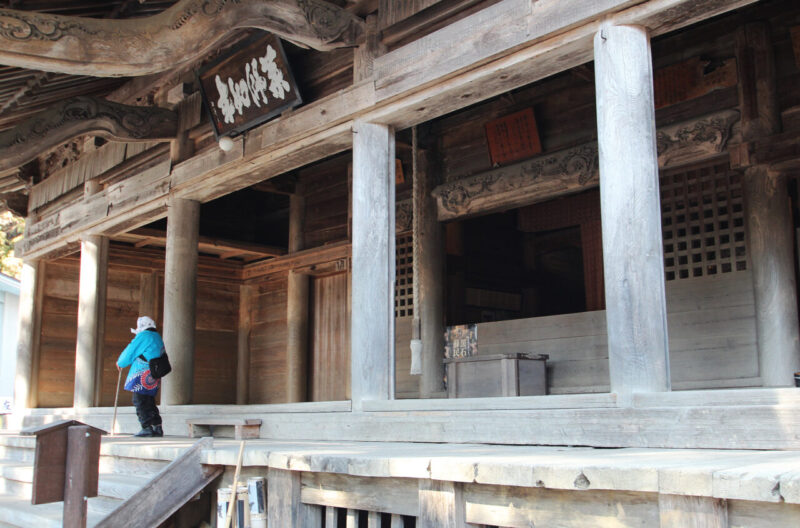
is where the climax of the festival, the Sominbukuro Battle, is held. It has a powerful and solemn atmosphere. At that time, I had no idea that something like this would happen here.

The details of the day's events were also posted. that ``Hitakinobori,'' the ritual of climbing on top of a pumped bonfire (saito goma) and praying while raising the spirits of the flames, will not take place.

There are straw huts located throughout the grounds for participants to change and rest. Although it is a very simple hut, you can feel the history and tradition that has been passed down here for a long time.
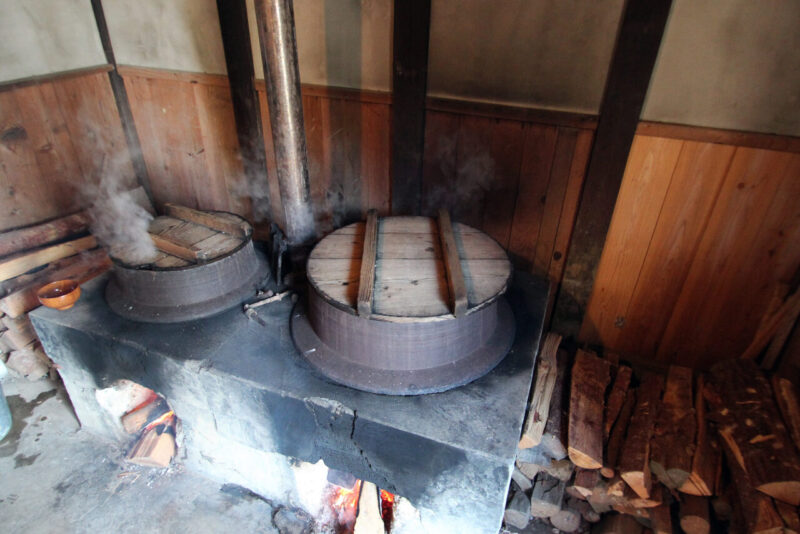
As I was walking around the temple grounds, a local person said to me, ``We're serving medicinal springs, so please come and have a drink.'' The storage room next to the main hall? In what appears to be a place, hot water with medicinal herbs was being simmered. It was almost tasteless, but I felt it was a blessing.
At 6pm, the Somin Festival finally begins!
After the daytime stroll, we returned to the car and waited until it was time. A little before 6 p.m., we moved back to the temple grounds and took up a position near the place where the Yamauchi River Suikori, the highlight of the naked pilgrimage, would be held.

Shortly after the time came, a voice shouted all at once from the main hall.
The voices shouting "Jasso!" got closer and closer, and soon a procession of naked pilgrims carrying lanterns descended the stairs toward the river.
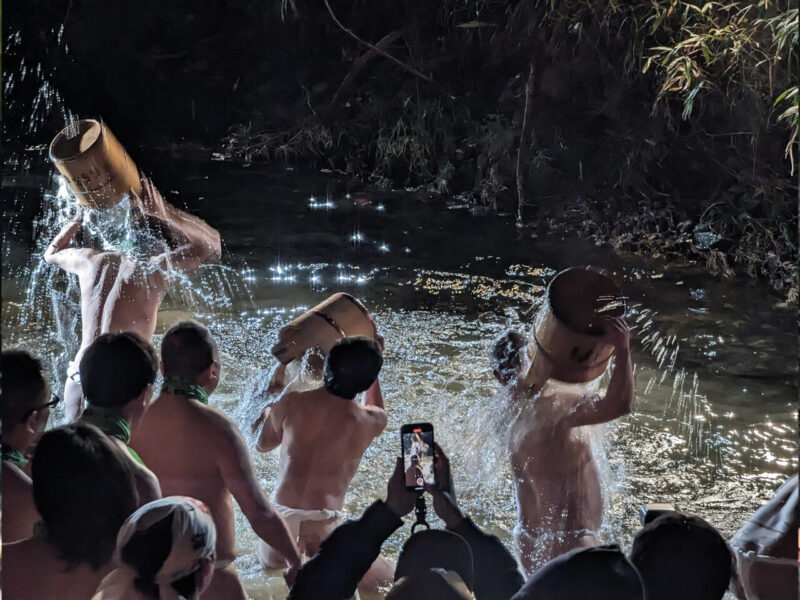
As I was admiring the endless lights of the square lanterns, the group at the front slowly began to clear the water. I felt like I was freezing just looking at it, but I didn't see a single person who was cold. In fact, everyone was smiling and seemed to be genuinely enjoying themselves.
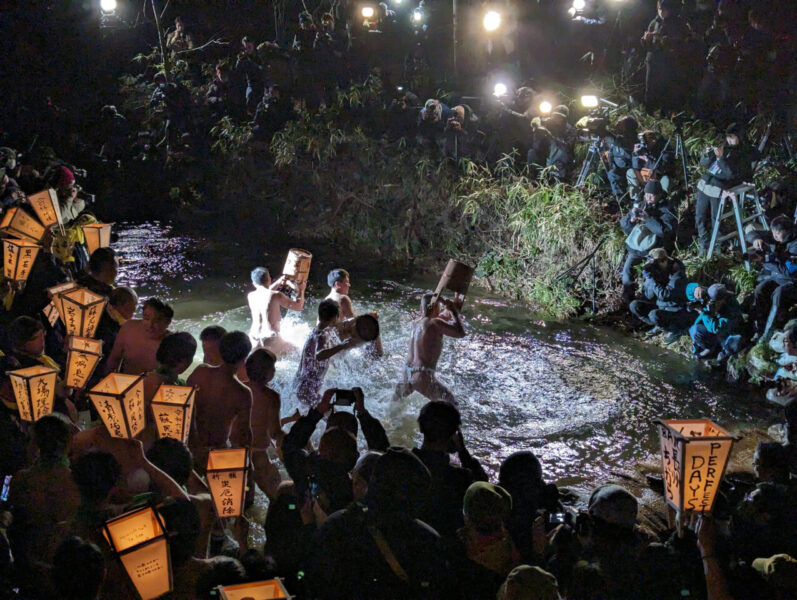
A picture of the Suikouri venue. There was an incredible number of media personnel and cameras on the other side.

Participants of the naked pilgrimage will visit the Yakushi-do and Myoken-do temples and perform the Mizuko Ri several times. All the while, chants of "Jasso!" echo throughout the shrine grounds.
After 7:00 p.m., the bell rings and the Betto Nobori climb begins.
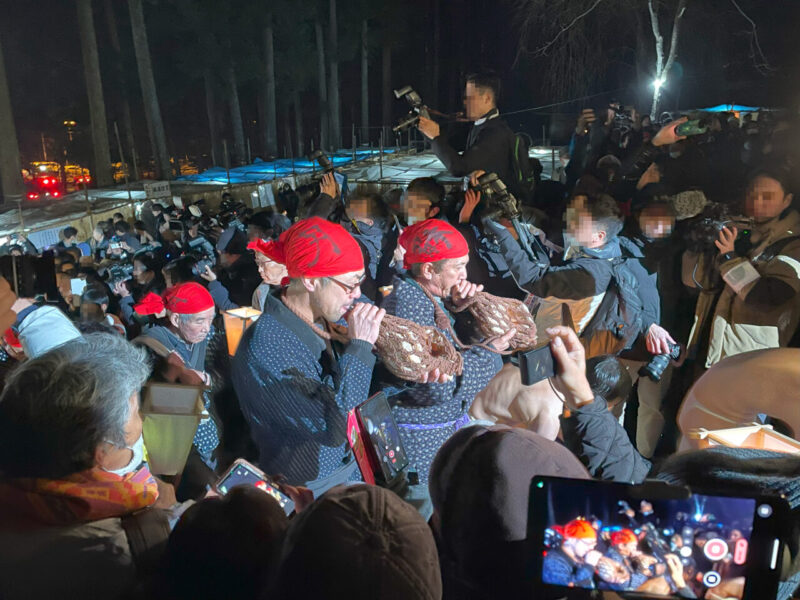
This is an event in which, when the bell rings as a signal, the betto and the general representative who has offered the sominbukuro are protected by guardians and exorcists, and accompanied by conch shells, drums, etc., climb into the inner sanctum of Yakushi-do Hall and perform a memorial service by burning a goma bonfire.
Betto is said to refer to the chief priest of Kuroishi-dera Temple.
Unable to bear the fatigue, I decided to eat and take a break.
At this point, 6 to 7 hours had passed at Kuroishi Temple, including waiting time. I decided to take a short break while having dinner.
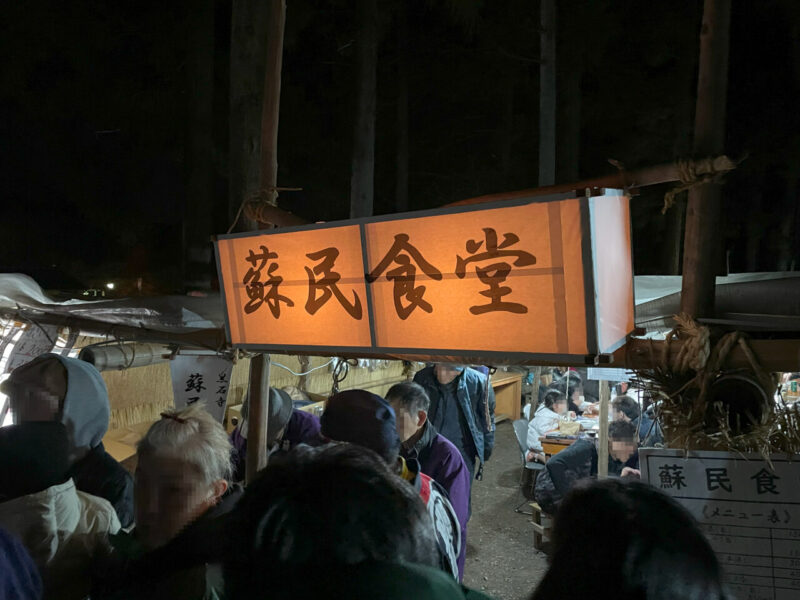
The name of the restaurant, Somin Shokudo, was located in the precincts of Kuroishi-ji Temple, along the approach to the shrine. They sold light snacks and drinks.

It's rude to say that it's poorly constructed, but the ceiling inside is quite low and the ground is uneven, making it difficult to stand in line.
However, the atmosphere was exceptional, and the combination of the brilliant light from the bare bulbs, the conversations and laughter of the locals having fun, and the uplifting atmosphere of the festival created an indescribably beautiful atmosphere.
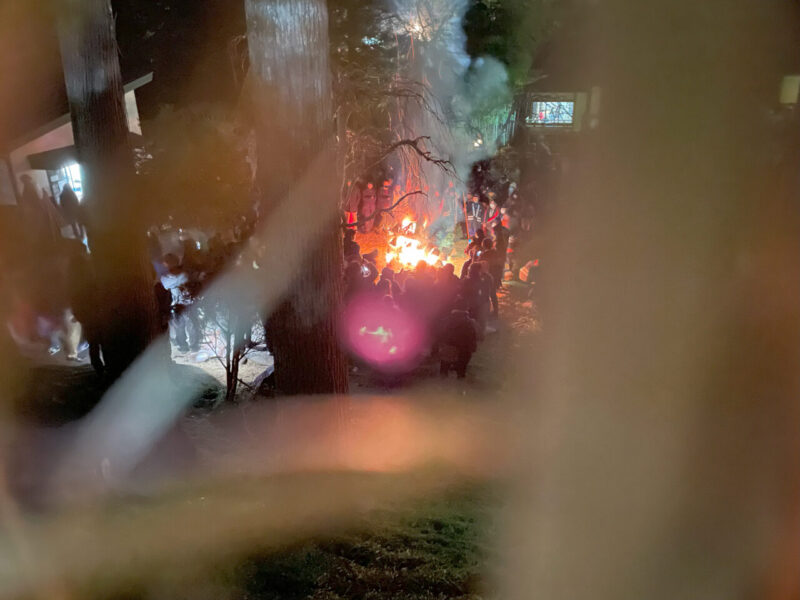
As you wait for your order, you can see a bonfire that appears to be a saito goma through a gap in the straw wall.
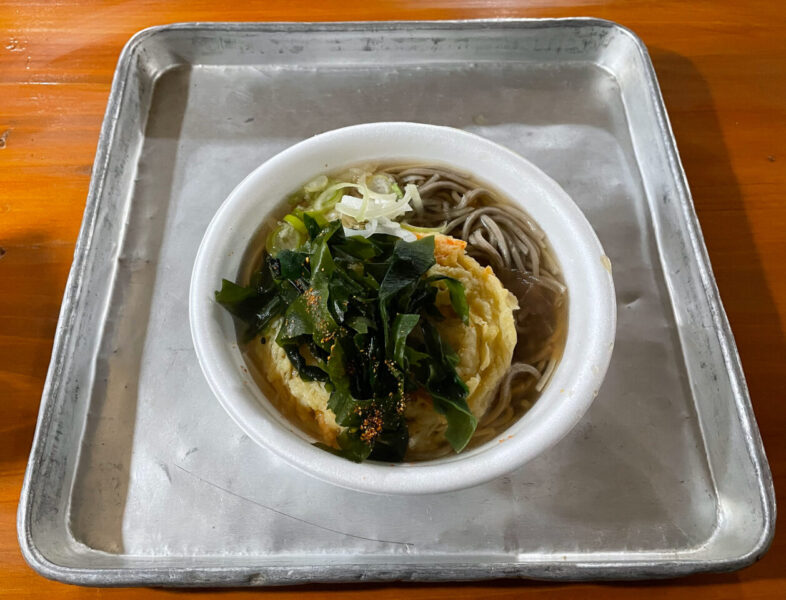
I ordered tempura soba. The taste was quite bland, but the Sominsai participants seem to be diligent about not eating meat, eggs, or strong-smelling vegetables, so that may have something to do with it.
I tried to go back to the main hall after a short break, but...
The number of visitors was incredible considering it was the last festival. Local elders at the cafeteria said, ``The turnout was more than expected.''
Once you leave the scene, you have no idea what's going on and can't return to the same place. was the Onigo nobori (onigo nobori) children used to pray, finishing their duty and running away.
After the break, I visited the main hall again in time for the Sominbukuro competition, and the following was the scene.
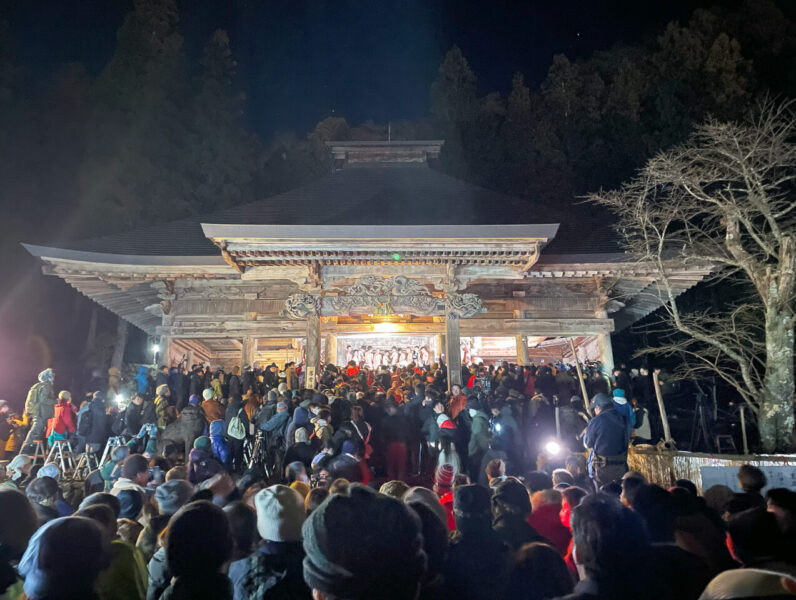
It is now difficult to approach the main hall...
Still, you can feel the atmosphere of the battle that is probably going on on the other side of that crowd. I will watch solemnly as this year's champion is decided.
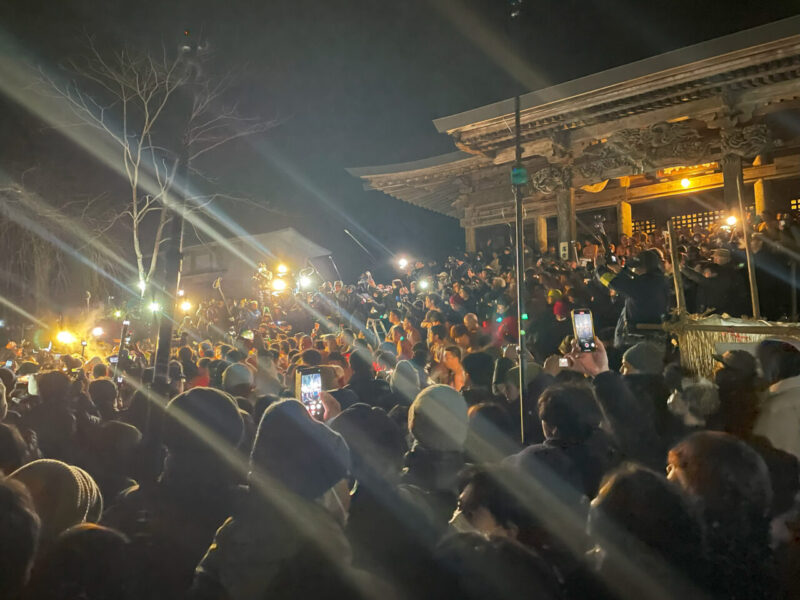
The climax is when men competing for Sominbukuro fall from the main hall into the precincts. It was a dangerous situation as there were a lot of people right up to the stairs of the approach, but it seems like we were able to finish the event without any accidents.
summary
This year marks the end of the Kuroishiji Somin Festival's history of over 1,000 years. It was a great experience to be able to see firsthand a chapter in a long history.
However, there seems to be a movement to revive the festival in the local area. It will not be easy to solve the problem of a lack of people to carry on the festival and a lack of successors, but I hope that someday we will hear good news about the revival of the Kuroishiji Somin Festival!
In Iwate Prefecture, there is a Sominsai that has been passed down for a long time in other areas, and it seems that there is a Sominsai that has been revived in recent years, so if you are interested, please check it out!
Kuroishi-dera <Information>
- Name: Tendai sect Myokenzan Kuroishi Temple
- Address: 17 Yamauchi, Mizusawa Kuroishi-cho, Oshu-shi, Iwate 023-0101
- Phone number: 0197-26-4168
- Official URL: https://www.kokusekiji.jp/



![The specialty of Genbikei, "Flying Dango," is definitely worth a visit! Delicious activities! [Ichinoseki City, Iwate Prefecture] Genbikei bus stop](https://jp.neft.asia/wp-content/uploads/2017/04/IMG_5931-150x150.jpg)
![Bottle Don is the definitive Sanriku souvenir that looks delicious! [Iwate Prefecture] Bottle don (abalone, scallop, salmon roe)](https://jp.neft.asia/wp-content/uploads/2023/06/IMG_5048-150x150.jpg)
![Ryusen-no-no-no-no-no-no-no-no-no-no-no-no-no-no-no-no-no-no-no-no-no-no-no-no-no-no-no-no-no-no-no-no-no-no-no-no-no-no-no-no-no-no-no-no-no-no-no-no-no-no-no-no-no-no-no-no-no-no-no-no-no-no-no-no-no-no-no-no-no-no-no-no-no-no-no-no-no-no-no-no-no-no-no-no-no-no-no-no-no-no-no-no-no-no-no-no-no-no-no-no-no-no-no-no-no-no-no-no-no-no-no-no-no-no-no-no-no-no-no-no-no-no-no-no-no-no-no-no-no-no-no-no-no-no-no-no-no-no-no-no-no-no-no-no-no-no-no-no-no-no-no-no-no-no-no-no-no-no-no-no-no-no-no-no-no-no-no-no-no-no-no-no-no-no-no-no-no-no-no-no-no-no-no-no-no-no-no-no-no-no-no-no-no-no-no-no-no-no-no-no-no-no-no-no-no-no-no-no-no-no-no-no-no-no-no-no-no-no-no-no-no-no-no-no-no-no-no-no-no-no-no-no-no-no-no-no-no-no-no-no-no-no-no-no-no-no-no-no-no-no-no-no-no-no- [Iwate Prefecture] Ryusendo Cave (first underground lake)](https://jp.neft.asia/wp-content/uploads/2023/07/PXL_20230512_052246926.NIGHT_-150x150.jpg)
![[Series ②: The role of the previous nine years and the role of the second three years] The role of the previous nine years is from the truce to the battle again, and the Kokufu army is struggling Taga Castle Ruins](https://jp.neft.asia/wp-content/uploads/2023/11/a0b8b1213124e7a13c7308fa81e053a2-150x150.jpg)
![[Iwate Prefecture] Soft-serve ice cream with sake, miso and wasabi flavor! Why are the soft serve ice cream eaten at roadside stations so delicious? There's also school lunches! Iwate Prefecture Catch](https://jp.neft.asia/wp-content/uploads/2025/06/915fd0ce722ab0f21e74864401170847-150x150.jpg)
![Tateishi-ji Temple, a corner of the four temple corridors, including Chuson-ji Temple, Mokoshi-ji Temple, and Zuigan-ji Temple [Yamagata Prefecture] Yamadera Risshakuji Temple](https://jp.neft.asia/wp-content/uploads/2016/09/26668581_m-150x150.jpg)

!["Negaseki" is one of the three ancient Oshu sekies that surpasses Minamoto Yoshitsune and Matsuo Basho [Tsuruoka City, Yamagata Prefecture] 3809167_m](https://jp.neft.asia/wp-content/uploads/2023/02/3809167_m-150x150.jpg)
